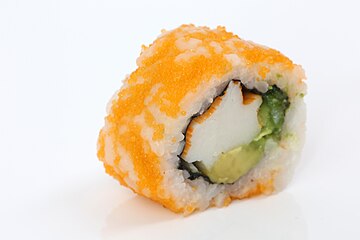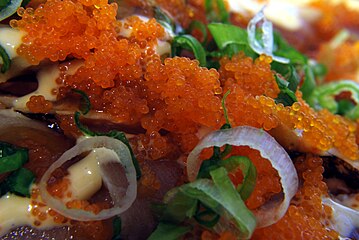Tobiko
This articleneeds additional citations forverification.(February 2013) |
Tobiko(とびこ)isflying fishroeinJapanese cuisine,known for its use insushi.[1]
The eggs are small, ranging from 0.5 to 0.8 mm. For comparison,tobikois larger thanmasago(capelinroe), but smaller thanikura(salmonroe). Naturaltobikohas a red-orange color, a mild smoky or salty taste, and a crunchy texture.
Tobikois sometimes colored to change its appearance: other natural ingredients are used to accomplish the change, such assquid inkto make it black,yuzuto make it pale orange (almost yellow), or evenwasabito make it green and spicy. A serving oftobikocan contain several pieces, each having a different color.[2]
When prepared assashimi,it may be presented onavocadohalves or wedges.Tobikois used in the creation of many otherJapanese dishes.Often, it is used as an ingredient inCalifornia rolls.
Frequently,masago(capelin orsmeltroe) is substituted fortobiko,due to its similar appearance and flavor.
-
Tobikoin varying colors, served assushi
-
Sushi roll covered intobiko
-
Tobiko,shown in its natural color, topping grilled albacore tuna
References
[edit]- ^admin (16 November 2016)."Tobiko vs Masago Difference".Expert Answer Question Help Forum. Archived fromthe originalon 17 November 2016.Retrieved22 April2021.
- ^"What Is Tobiko and What's Up With the Different Colors?".Food Republic.19 April 2013. Archived fromthe originalon 23 October 2014.Retrieved18 October2014.
External links
[edit] Media related toTobikoat Wikimedia Commons
Media related toTobikoat Wikimedia Commons





